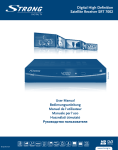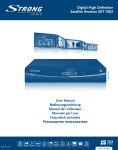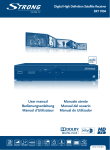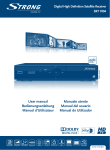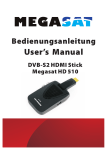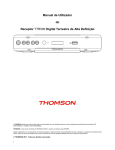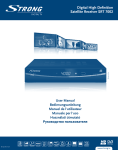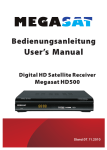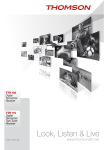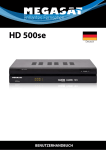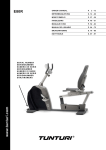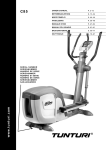Download Look, Listen & Live
Transcript
ow D d de oa nl m fro de an .v w w w re or nb e .b THS220 Digital High Definition Satellite Receiver User manual Bedienungsanleitung Manuel d’utilisation Manuale d’uso Руководство пользователя Look, Listen & Live www.thomsonstb.net ow D d de oa nl m fro de an .v w w w re or nb e .b ow D d de oa nl m fro de an .v w w w re or nb e .b ow D d de oa nl m fro de an .v w 2 2 3 3 3 4.0 First Time Installation 7 5.0 Quick guide for using your receiver 6.0 Operation 8 8 4.1 Installation 6.1 Changing channels 6.2 Info Banner 6.3 Selection of audio language 6.4 Teletext 6.5 Subtitles 6.6 Changing the Aspect Ratio 6.7 Changing the resolution 6.8 EPG (Electronic Programme Guide) 6.9 Favourite channels 6.10 Changing between DTV/VCR contents 4 4 4 4 6 6 6 6 7 7 8 9 9 9 10 10 10 10 10 10 7.0 Main Menu 11 8.0 Troubleshooting 9.0 Specifications 23 24 7.1 Programme 7.2 Picture 7.3 Channel Search 7.4 Time and Date Settings 7.5 Option 7.6 System Settings 7.7 USB e 6 3.1 Basic connection using a Scart cable 3.2 Basic connection using an HDMI cable 3.3 Connecting multiple fixed LNBs using a DiSEqC 1.0 switch .b 3.0 Connections re 4 or nb 2.0 Your Receiver 2.1 PIN code default: 0000 2.2 Front panel 2.3 Rear panel 2.4 Remote Control 2.5 Installing the Batteries 2.6 Using the remote control 03 Jul 2013 14:47 2 w 1.1 Safety Instructions 1.2 Storage 1.3 Equipment Set-up 1.4 Accessories 1.5 Usage of external USB devices w 1.0 Instruction English Table of Contents 11 13 14 17 18 19 20 THOMSON declares that this item complies with the basic requirements and other relevant regulations of directives CE 2004/108/EC and 73/23EEC; RoHS 2002/95/EC Subject to alterations. In consequence of continuous research and development technical specifications, design and appearance of products may change. All product names are trademarks or registered trademarks of their respective owners. © THOMSON 2012. All rights reserved. P1 ow D m fro de an .v Your receiver and its accessories are stored and delivered in a packaging designed to protect against electric shocks and moisture. When unpacking it, make sure that all the parts are included and keep the packaging away from children. When transporting the receiver from one place to another or if you are returning it under warranty conditions, make sure to repack the receiver in its original packaging with P2 INSTRUCTION e 1.2 Storage .b Safety Precautions try to open the receiver. It is dangerous to touch the inside of the receiver due to high voltages and possible electrical hazards. Opening the receiver will void the warranty of the product. Refer all maintenance or servicing to suitably qualified personnel. yy When you are connecting cables, be sure that the receiver is disconnected from the mains supply voltage. Wait a few seconds after switching off the receiver before you move the receiver or disconnect any equipment. yy It is a necessity that you only use an approved extension and compatible wiring that is suitable for the electrical power consumption of the installed equipment. Please ensure that the electrical power supply corresponds with the voltage on the electrical identification plate at the back of the receiver. If the receiver does not operate normally even after strictly following the instructions in this user manual, it is recommended to consult your dealer. yy Never re DO NOT EXPOSE THE RECEIVER OR ITS ACCESSORIES: direct sunlight or any other equipment that generates heat; to rain or intense moisture; to intense vibration and to any shock which may cause permanent damage to your receiver or to any magnetic objects, such as loudspeakers, transformers, etc. yy Do not use a damaged power cord. It may cause a fire or an electric shock. Do not touch a power cord with wet hands. It may cause an electric shock. yy When the receiver is not used for a long period of time, you should unplug the power cord from the wall socket. yy Do not use alcohol or ammonia based liquids to clean the receiver. If you wish, you may clean your receiver with a soft lint-free cloth slightly made damp with a mild soap solution, and only after disconnecting from the mains voltage supply. Make sure no foreign objects fall through the ventilation slots because this could cause fire or an electric shock. yy Do not place any objects on top of the receiver because this might prevent proper cooling of the components inside. yy To or nb DO NOT INSTALL YOUR RECEIVER: a closed or poorly ventilated cabinet; directly on top of or under any other equipment; on a surface which might obstruct the ventilation slots. yy In w w w 1.1 Safety Instructions d de oa nl 1.0 Instruction ow D d de oa nl m fro its accessories. Failing to comply with such packaging procedures could damage the product and void your warranty. .v w w English w 1.3 Equipment Set-up de an We recommend you consult a professional installer to set up your equipment. Otherwise, please follow the instructions below: yy Refer to the user manual of your TV and your antenna. yy Make sure that the SCART/HDMI cable and outdoor components are in a good condition and the SCART/HDMI connections are well shielded and from good quality. This manual provides complete instructions for installing and using this receiver. The following symbols will serve as follows. MENU (Bold Characters) Move to (Italic Characters) e Indicates any other additional important or helpful information. .b Note: re Indicates warning information. or nb Warning: Represents a button on the remote control or the receiver. Represents a menu item within a window. 1.4 Accessories yy 1 User Manual yy 1 Remote control yy 2x Batteries (AAA unit type) Note: The batteries should not be recharged, disassembled, electrically short-circuited or be mixed or used with other types of batteries. If rechargeable accumulators instead of batteries are going to be used, we recommend using (e.g. NiMH) types with low self-discharge to ensure long time operation of remote control. 1.5 Usage of external USB devices yy It is recommended to use USB 2.0 storage devices. If your device is not compatible to USB 2.0 specifications, multimedia functions of the receiver might not work properly. yy THOMSON cannot guarantee compatibility with all types of USB storage devices. yy It is advised not to store important information on USB storage devices used with the receiver. Always make backups of data on your USB storage device before using it with this receiver. THOMSON will not take responsibility for any loss of information or circumstances caused by loss of information. yy Please ensure that either the USB device is already formatted to FAT/FAT32, or format the USB device via your receiver, refer to chapter 7.7 USB for details. P3 INSTRUCTION ow D m de an .v w w w 2.4 Remote Control P4 Fig. 3 1.qTurns the receiver ON/standby 2.!To turn the sound on or off 3.REDAlphabetic search of channels in channel list mode; several functions in the OSD menu and Teletext 4.GREENIn viewing mode: changes the resolution of the HDMI output between 1080p, 1080i, 720p, 576p and 576i; several functions in the OSD menu and Teletext. YOUR RECEIVER e Fig. 2 1.SAT INTo connect to the LNB of your satellite dish for reception of satellite broadcast signal 2.SAT OUTTo loop through the satellite signal to a second receiver 3.S/PDIFTo connect to a digital or home cinema audio amplifier 4.HDMITo connect to the HDMI input of your TV using a good quality HDMI cable. 5.TV SCART To connect to TV using a SCART cable 6.DVD/VCR SCART To connect to a Video or DVD recorder 7.Power cordThe receiver requires a mains voltage of 100~240V AC 50~60Hz (auto selecting). Please check the local power conditions before connecting the receiver to the mains supply. .b 2.3 Rear panel re Fig. 1 1.Standby/on button: To turn the unit ON or to standby mode. 2.Channel up/downTo change channels without using the remote control 3.Volume up/down To change volume without using the remote control 4.Remote control sensor: Receives the signal from the remote control 5.Standby indicator:Shows power state of the receiver Green LED - receiver is turned on Red LED - receiver is in standby mode 6.LED display:Shows channel number in operation and time in Standby 7.USB For connection of external storage devices or nb 2.2 Front panel fro 2.1 PIN code default: 0000 d de oa nl 2.0 Your Receiver ow D d de oa nl m fro 5.YELLOWIn viewing mode: changes the aspect ratio and aspect conversion of video outputs; several functions in the OSD menu and Teletext 6.BLUEIn viewing mode: displays the schedule menu for easy setup of timers; several functions in the OSD menu and Teletext. 7.SUBTITLETo select one of the available subtitles languages for the current channel 8.TEXTTo open Teletext if available on the current channel 9.AUDIODisplays the audio selection menu for available languages and audio modes 10.RECALLTo switch between the last viewed channels 11.5Searches backwards during playback. Each pressing increases the speed (x2 – x32) 12.6Searches forwards during playback. Each pressing increases the speed (x2 – x32) 13.7Jumps to the previous file during playback 14.8Jumps to the next file during playback 15.uStarts/resumes playback 16.2Freezes/resumes playback of multimedia files 17.3Stops playback of multimedia files 18.REPEATSelects different repeat modes during playback 19.MENUTo open the main menu in viewing mode or to go one step back in the menu 20.EXITGo one step back in the menu/cancellation of current process/exit from the main menu to viewing mode 21.pqSwitches to the next/previous channel in viewing mode, switches to the next/previous page in the channel list or moving the highlight up/down in the menu. 22.OKViewing mode: displays the channel list. Menu: activation of the highlighted item 23.tuDecreases/increases the volume level in viewing mode/navigating through the menus/changing values of settings in a menu 24.EPGViewing mode: displays the EPG (Electronic Programme Guide) 25. Press once to display channel number/name and current/next info. Press twice to display detailed event info and transponder/signal strength information. Press again – back to viewing mode 26.VOL+/-Increases/decreases the volume level in TV mode 27.FAVTo access your favourite channels. Toggles between available favourite groups de an .v w w English w re or nb e .b P5 YOUR RECEIVER ow D d de oa nl m fro 28.GOTOIn playback mode: opens the time banner for selecting the moment where to jump to 29.P +/-Switches to the previous/next programme in TV mode 30.DTV/VCRSwitches to VCR input if the receiver is in DTV state. Switches to DTV if it is in VCR state 31.0-9Channel number and numeric value input 32.TV/RADIOToggles between TV and radio mode de an .v w w w 2.6 Using the remote control Fig. 5 To use the remote control, point it towards the front of the digital receiver. The remote control has a range of up to 7 metres from the receiver, if properly aligned towards the IR eye on the front panel. The remote control will not operate if its path is blocked. Note: unlight or very bright light (such as TL lighting) might decrease the S sensitivity of the remote control. 3.0 Connections 3.1 Basic connection using a Scart cable Fig. 6 a. Connect the LNB of your satellite antenna to the SAT IN connector of your receiver using a good quality coax cable and suitable ‘F-connector’ plugs. b. Connect one end of a good quality Scart cable to the TV SCART connector on your receiver and the other end to the SCART input of your TV. c. P lug the power cord to a suitable wall outlet. 3.2 Basic connection using an HDMI cable P6 CONNECTIONS Fig. 7 e he batteries should not be recharged, disassembled, electrically T short-circuited, be mixed or used with other types of batteries. .b NOTE: re Fig. 4 Remove the battery cover from the remote control and put 2x AAA size batteries inside the compartment. The diagram inside the battery compartment shows the correct way to install the batteries. 1.Open the cover 2.Install batteries 3.Close the cover or nb 2.5 Installing the Batteries ow D d de oa nl m fro a. Connect the LNB of your satellite antenna to the SAT IN connector of your receiver using a good quality coax cable and suitable ‘F-connector’ plugs. b. C onnect one end of a good quality HDMI cable to the HDMI output on your receiver and the other end to the HDMI input of your TV. c. Plug the power cord to a suitable wall outlet. de an .v w w English w re or nb e .b 3.3 Connecting multiple fixed LNBs using a DiSEqC 1.0 switch Fig. 8 a. Connect the LNBs of your fixed antenna to the inputs of a DiSEqC 1.0 switch b. Connect the output or “to receiver” connector of the DiSEqC 1.0 switch to the SAT IN connector on your receiver. c. R efer to section 3.1 or 3.2 for TV and mains connections. 4.0 First Time Installation After all connections have been made properly, turn on your TV and make sure the receiver is connected to the main power. If you are using the receiver for the first time or restored it to factory default, the First Installation menu will appear on your TV screen. Use the tu buttons to select the OSD Language of your preference and press OK to confirm. An Info page will be displayed. Read the info guide and press the button to proceed to the next Installation step. You can open and close the info page again by using the button. Note: If German is selected as language, German preset channels from ASTRA 19.2E will be installed. You can continue with the Installation menu to scan and install further channels as described below or directly go to viewing mode by pressing the EXIT button twice to start enjoying the pre-installed channels immediately. 4.1 Installation 4.1.1 Satellite Selection Use pq to highlight the satellite your dish is aimed at. When using a multi feed antenna with more than 1 LNB, select the satellites your antenna is adjusted for by pressing the OK button and set the LNBs in the DiSEqC point. The scan process will then search on all selected satellites. 4.1.2 Signal Adjust The signal quality bar on the bottom of the screen allows you to fine tune the alignment of your antenna for optimum reception. Adjust your antenna for maximum possible signal quality. When the signal cannot be improved anymore, fix the dish on this position and press the BLUE button for Scan. P7 FIRST TIME INSTALLATION ow D d de oa nl m fro 4.1.3 Scan Mode Use pq tu to highlight your options of choice and press OK to start the Channel Search. It is recommended to use the default settings. .v w w w de an 4.1.4 Channel Search Your receiver will now perform an automatic channel search. When the process has been completed, all found channels will be stored and the receiver will switch to the first channel in the channel list. You are now ready to enjoy your new receiver. 6.0 Operation In viewing mode, several features are available to make watching TV a true pleasure. This paragraph describes these features. Please also read chapter 7 to get familiar with the menu of your new receiver. 6.1 Changing channels There are different ways to change channels with your new receiver. Via direct access Via the channel list Via the pq buttons. Via the RECALL button. 6.1.1 Direct access To gain direct access to a certain channel, simply input its number with the 0~9 buttons on the remote control. Channel numbers can be up to four digits long. Entering a number with less than four digits is possible. Just wait a few seconds and your receiver will switch to the selected channel. P8 QUICK GUIDE FOR USING YOUR RECEIVER e We at THOMSON understand that you can’t wait to enjoy your new HD receiver. The following quick guide will make you familiar with the basic operation of this device. We do, however, advice you to read the full manual to get the best performance from your THOMSON HD receiver. To turn your receiver ON or to standby, use the q button on the remote control or the button on the front panel. Choose a channel with the pq buttons. Alternatively, you can digit the channel number with the 0~9 buttons on the remote control or press OK in viewing mode to display the channel list. The volume can be adjusted with the tu buttons. .b 5.0 Quick guide for using your receiver re If no channels were found during the automatic channel scan, the receiver will return to the First Installation menu. Please select your language again and refer to chapter 7.3 for further instructions. or nb Note: ow D d de oa nl m fro 6.1.2 Channel list Press OK in viewing mode to display the channel list. Use pq to highlight your channel of choice and press OK once to select the highlighted channel. The channel list is equipped with a Find function to make it easier to find a certain channel. Press RED in the channel list. An alphabet banner will now be displayed. Use pq to select the first letter (or letters) of the channel and OK to confirm. All channels beginning with the chosen letter(s) will now be displayed. Close the alphabet banner by moving the highlight to OK. Now press OK and select the channel in the filtered list. The following buttons are available in the channel list and viewing mode: RED:Opens an alphabet banner for quickly finding a channel TV/RADIO:Toggles between TV and radio channels GOTO:Opens the Satellite List for satellite selection In viewing mode: FAV:To switch to one of the available favourite lists. de an .v w w English w re or nb e .b 6.1.3 Using the pq buttons p will switch to a higher channel. q will switch a lower channel. 6.1.4 Using the RECALL button Use the RECALL button for switching between the last viewed channels. Please refer to section 7.6 for more details. 6.2 Info Banner At any time during viewing mode you can press the button to get information about the current channel as well as the current and following programme*. Press twice to view detailed info on the current and following programmes and technical details about the current channel. Press again or EXIT to close the information. You can change the on screen duration of the info banner in the Option menu. Please refer to section 7.5 for more details. *Programme information is displayed when available. Availability depends on broadcast. 6.3 Selection of audio language Some channels support a choice of different audio formats and/or languages. To select another audio stream, press AUDIO in viewing mode. A list with available audio streams will now be displayed. Use pq to select a stream and confirm with OK. With the tu buttons you can select between mono left, mono right or stereo audio. 6.4 Teletext Your receiver includes a fully featured Teletext. To access Teletext, press the TEXT button in viewing mode and use the 0~9 or pq buttons to select the number of the page you want to see. Subpages (if loaded and available) can be selected with the tu buttons. The coloured buttons of the remote control allow you to jump to P9 OPERATION ow D d de oa nl m fro selected pages directly, as indicated on the bottom of the teletext screen. Press TEXT again or EXIT to go back to viewing mode. .v w w w 6.5 Subtitles de an Some programmes support a choice of different DVB subtitle languages. Press the SUBTITLE button in viewing mode to display a list of available subtitle languages. Use pq to select the subtitle language and confirm with OK. 6.8 EPG (Electronic Programme Guide) The Electronic Programme Guide is a very useful function that allows you to watch programme schedules and information on screen. Press the EPG button to activate this guide (you can also enter the EPG via the menu, too). Use pq tu to select a channel and RED to move the highlight to the programme list. In the programme list, use pq to select or scroll through programmes and tu to display programme information for the next/previous days. Use BLUE to display detailed information about the selected programme. If there is more than one page of information, use tu to scroll. Note: Availability of EPG data depends on broadcast. Booking a programme from EPG Select a programme as described above. Press OK when you have selected the programme. This will lead you to the Timer (Schedule) menu. All details are already filled in for you. Save the timer with OK. To display the list of booked events just press the BLUE button in the channel list part of the EPG or in viewing mode. Please refer to section 7.4.1 for more details. 6.9 Favourite channels Use the FAV button to access your favourite channels and to toggle between available favourite groups. Please refer to section 7.1.1 for details on how to create favourite lists. 6.10 Changing between DTV/VCR contents The receiver has the possibility to loop through the signal from the VCR SCART input to the TV SCART. This allows you to watch content from the connected DVD or VCR recorder via the receiver. P10 OPERATION e To change the Resolution while watching TV, simply press the GREEN button in viewing mode. Each press will switch to the next format. Please refer to section 7.2 for more details. .b 6.7 Changing the resolution re To change the Aspect Ratio while watching TV, simply press the YELLOW button in viewing mode. Each press will switch to the next format. Please refer to section 7.2 for more details. or nb 6.6 Changing the Aspect Ratio ow D d de oa nl m fro Switching between DTV/VCR modes in operation mode is realized by using the DTV/VCR button. “AV IN” will be displayed on the front LED when receiver is in VCR mode. Press the DTV/VCR button again to return to the digital TV content. Please refer to Loop Through point in section 7.2 for more details. de an .v w w English w nb re or 7.0 Main Menu e .b 7.1 Programme Press MENU and select Programme using the tu buttons. Press OK or the q button to enter the Programme submenu. Press OK or the u button to edit programme settings. Press EXIT to exit the menu. 7.1.1 Programme Edit To edit your programme preferences (lock, skip, favourite, move or delete), please go to the Programme Edit menu. This menu requires a password upon access. Enter your password or use the default password '0000' if you did not change it. Use pq tu to highlight a channel, TV/RADIO to toggle between TV and radio channel lists and GOTO to select a satellite (if more than one available). Set favourite programme Your receiver allows you to store channels in up to 4 favourite lists. Due to the large number of channels available on satellite nowadays, this can be a very useful function. 1.Highlight the preferred programme then press the FAV button. A Favourite Type window will pop up on screen. The following 4 groups are available: Movie, News, Sport and Music. Please select one (or more) of them. A star shaped symbol will appear and the programme is marked as a favourite. Press EXIT to return to the channel list for further selection. 2.Repeat the previous step to select more favourite programmes. 3.To confirm and exit the menu, press EXIT Disable favourite TV or radio programme Repeat step 1 described above and select Disable in the Favourite Type window. View favourite programme 1.Press the FAV to display a list of favourite programmes in normal viewing mode (no menu mode). While in the favourite list, use tu to switch between available favourite lists. 2.Select your favourite programme with pq and press OK to switch to it. 3.Now you can select channels from the chosen favourite group only by pressing pq in viewing mode. If you want to change to the main channel list press OK in viewing mode and then press GOTO and select All satellites. Delete a TV or radio programme 1.Select the programme you want to delete and press the BLUE button. A message will appear. Press OK to delete the programme or EXIT to cancel. 2.Repeat the previous step to delete more programmes. MAIN MENU P11 ow D d de oa nl m fro Skip TV or radio programme 1.Select the programme you want to skip and press the GREEN button. 2.The programme will be marked to skip. The receiver will skip this programme while zapping between programmes in normal viewing mode (in the channel list mode the skipped channels remain selectable). 3.Repeat the previous step to skip more programmes. 4.To confirm and exit the menu, press EXIT. de an .v w w w Rename a TV or radio programme 1.Select the programme you want to rename and press the button. A key table appears. 2.In the key table select a character by using the navigation buttons. Press OK to enter the character. When you have entered the new name, navigate to the “OK” button on screen and press OK on the remote control to confirm the new name. 3.To store the changes and exit the menu, press EXIT. 7.1.2 EPG (Electronic Programme Guide) Please refer to section 6.8 above. 7.1.3 Sort Here you can sort your channels in the following order: Default:Sort the channels in the original order By Service Name:Sort the channels in alphabetical order (A-Z) By Frequency:Sort the channels in frequency order (Low-High) P12 MAIN MENU e Disable a locked TV or radio programme Press the YELLOW button on the programme marked with the lock symbol. .b Locking programmes You can lock selected programmes for restricted view. 1.Select the programme you want to lock, then press the YELLOW button. The programme is now marked as locked. 2.Repeat the previous step to select more programmes 3.To confirm and exit the menu, press EXIT. To view a locked programme, you need to enter either the default password '0000' or your last set password. We recommend changing the default password to one of your preference. Please refer to chapter 7.6 System for more details. re Move a TV or radio programme 1.Select the programme you want to move, then press the RED button. A move symbol will appear. 2.Press pq tu to move the programme. 3.Press OK or RED again to confirm the new position. 4.Repeat the steps above to move more channels. or nb Disable a skipped TV or radio programme Press the GREEN button on the programme marked with the skip symbol. ow D m fro w English w 7.2 Picture d de oa nl By Encrypt:Sort the channels from free to scrambled de an .v w Press MENU, then select Picture. In this menu you can adjust the video settings. Press pq to select an option and tu to adjust the setting. Press EXIT to exit the menu. re e .b Tip: or nb Aspect Ratio The default and recommended format is Auto. You can also set the display format to available settings like 4:3 Full Screen, 4:3 Pan&Scan, 4:3 Letter Box and 16:9 Wide Screen. 4:3 Letter Box:The full 16:9 picture will be displayed on your 4:3 TV set with black bars above and below the picture. 4:3 Pan&Scan:The centre of the 16:9 picture will be displayed full-screen on your 4:3 TV 4:3 Full Screen:Combination of Letter-box and Pan&Scan. 16:9 Wide Screen:Select when using a 16:9 TV set. ou can change the video output format directly from viewing mode Y by pressing the YELLOW button on the remote control. Resolution If the video does not appear correctly, change the setting. These settings match the most common settings for HDMI. 480i: for NTSC system TV. 480p: for NTSC system TV. 576i: for PAL system TV. 576p: for PAL system TV. 720p: for NTSC or PAL system TV. 1080i: for NTSC or PAL system TV. 1080p: for NTSC or PAL system TV. Tip: ou can change the video resolution directly from viewing mode by Y pressing the GREEN button on the remote control. TV format Set the standard corresponding to your TV set. Available options are: PAL and NTSC. Video output This setting is only relevant when the receiver is connected to the TV set via Scart. Select RGB for the best picture quality or CVBS in case your TV doesn’t support RGB. Loop through (VCR to TV Scart) This option is only relevant if you have a device (video-/DVD-recorder) connected to the VCR scart connector of your receiver. Its signal will be looped through to P13 MAIN MENU ow D d de oa nl m fro the TV scart output of your receiver. Use this option to set the preferred loopthrough mode. Running mode:The Loop through will be switched off when the receiver is in standby mode. Always:The Loop through is always on – in operation and in standby mode. Switching between DTV/VCR contents in the operation mode is realized by using the DTV/VCR button on the remote control. “AV IN” will be displayed on the front LED display when the receiver is in VCR mode. Press the DTV/VCR button again to return to the digital TV content. de an .v w w w 7.3.1 Installation 7.3.2 Satellite Selection Use the pq buttons to highlight the satellite your dish is aimed at. Its antenna settings will be shown at the right side. You can enter the right side with the tu buttons and return to the satellite list with EXIT. 7.3.3 Configure the antenna settings for selected satellite LNB Type:Press tu or OK to show the list of LNB Types which is shown as frequencies. You also can enter customized frequencies with User Single or User Dual at the bottom of the list. The default setting is Universal LNB (09750/10600) – the most used on the market. LNB Power:Use tu to set the LNB power. 13/18V is the setting for a Universal LNB. 22KHz:Use tu to switch the 22 KHz oscillator signal on or off. Auto is the setting for a Universal LNB. Toneburst:To enable or disable the toneburst switcher if available. DiSEqC1.0:To select the right port from up to 4 (if available) for the right LNB. DiSEqC1.1:To select the right port from up to 16 (if available) for the right LNB. Motor:If using a motor, use tu to select between DiSEqC1.2 or GOTOX depending on the motor type you use. Then Press OK to show the menu to set the position or GREEN for location. P14 MAIN MENU e To access the menu, press MENU and select Channel Search. It contains two options:Installation and DB (Data Base) Management. Select an option and press OK to enter it. Press EXIT to exit the menu. .b 7.3 Channel Search re he setting "Always" increases the power consumption in standby T mode. The front panel LED remains green in standby! or nb Note: ow D d de oa nl m fro DiSEqC1.2:Move the motor to the right position for locking the signal like explained below. Move Continue:press tu for moving West/East. It will keep moving as long as the button is hold pressed. Pressing once moves in 1°step. Move Step (1):press tu for moving West/East in 0.3° step. Store Position:to store the current motor position for the selected satellite. Goto Reference:to go to the reference 0° position. DiSEqC1.3:Select DiSEqC1.3 with the tu buttons. Press GREEN to setup your location coordinates. A pop-up window will appear, in which the following settings can be made: Location:Use tu to select one of the pre-set locations. Choose a location nearest to you. If you know the coordinates of your place of residence, you can choose Manual and make the following extra adjustments: Longitude Direction:Choose East or West. Longitude Angle:Use the NUMERIC buttons to enter the coordinate. Lattitude Direction: Choose North or South. Latitude Angle:Use the NUMERIC buttons to enter the coordinate. Once all setting are made, press EXIT to save the data and leave the window. Now press OK to enter the DiSEqC1.3 menu. Move Auto will move the dish to the selected satellite automatically. For Move Continue, Move Step (1) and Goto Reference please see explanation above. de an .v w w English w re or nb e .b 7.3.4 Channel Scan Automatic Scan Single Satellite Scan:Press BLUE for Scan. A window with scan settings will be displayed. Scan Mode:Use tu to select Default, Blind Scan or NetWork. Default:All stored transponders in the memory will be scanned. Blind Scan:Slow scan in 2 MHz steps. The receiver will first scan the whole frequency band to find the transponders it can lock on. After gathering all transponders, it scans the transponders one by one to get all available programmes. NetWork:Network search will be performed – when network information is broadcasted, new transponders will be found and stored. Crytped:Press tu to select All Channels (scrambled and free) or FTA Channels (free to air); Service Type:Press tu to select ALL, DTV or Radio. After configuring, press OK or BLUE again to start scanning with the selected settings. Your receiver will now perform an automatic channel search with the scan progress shown on screen. During the channel search you can skip transponders by pressing the MENU button, or quit the scan process with EXIT. When the process MAIN MENU P15 ow D d de oa nl m fro has been completed, all found channels will be stored and the receiver will switch to the first found channel. Multi-Satellites Scan:When using a multi feed antenna with more than 1 LNB, select the satellites your antenna is adjusted to with the OK button. The selected satellites will be marked by the "“ symbol. Set the LNB inputs in the DiSEqC point and press BLUE for Scan. A window with scanning settings will be displayed. After configuring the settings like explained in Single Satellite Scan above, press OK or BLUE again to start Multi-Scan on all selected satellites. de an .v w w w e MAIN MENU .b P16 re 7.3.6 Satellite Edit options Add satellites:Press RED to add a new satellite. In the pop-up banner, enter the satellite's name and position by using the navigation and numeric buttons. Satellite Name:Press OK to enter text input mode. In the key table select a character by using the navigation buttons. Press OK to input the chosen character. When you have entered the name, navigate to the “OK” button on screen and press OK on the remote control to confirm the new name. Save the settings with OK or cancel with EXIT. Edit satellites:Press GREEN to edit the focused satellite. For changing settings see explanation above. Confirm changes with OK or cancel with EXIT. Delete satellite:Press YELLOW to delete the focused satellite. Press OK to confirm deleting or EXIT to cancel. or nb 7.3.5 Scanning by transponder (Manual Scan) Press GOTO for displaying the transponder list of the highlighted satellite. By pressing GOTO again you switch back to the satellites list. Single Transponder Scan:Use the pq buttons to highlight the transponder you want to scan. Press BLUE for Scan. A window with scanning settings will be displayed. After configuring the settings (explained in 7.3.1.3 above), press OK or BLUE again to start scanning the highlighted transponder. When the scan process has been completed, all found channels will be stored and the receiver will switch to the first found channel. Multi-Transponder Scan:Select the transponders you want to scan with the OK button. The selected transponders will be marked with the "“ symbol. Press BLUE for Scan. A window with scan settings will be displayed. After configuring the settings like explained in 7.3.1.2 above, press OK or BLUE again to start multi-scan on all selected transponders. ow D d de oa nl m fro 7.3.7 Transponder Edit options Transponders can only be edited when the transponder list is on screen. To do this, select the satellite you wish to edit and press GOTO to open the TP list. The options below are now available. Add transponder:Press RED to add a new transponder. In the pop-up banner, enter the transponder´s data with the navigation and numeric buttons. Confirm the settings with OK or cancel with EXIT. An existing TP cannot be stored again under the same satellite. Edit transponder:Press GREEN to edit the highlighted transponder. In the pop-up banner, change the transponder´s data with the navigation and numeric buttons. Confirm changes with OK or cancel with EXIT. Delete transponder:Press YELLOW to delete the highlighted transponder. Press OK to confirm or EXIT to cancel. de an .v w w English w re or nb e .b 7.3.8 DB Management This menu allows you to save and reload the channel data base of your receiver from/to a USB-device. This very convenient feature enables you to save your personal settings like Channel-, Favourite-, Sat- and TP-lists on a USB storage device and load them back to the receiver later. This feature is especially helpful after unintentional changes or factory reset. In such cases just skip the First Installation by pressing EXIT in the First Installation and select the DB management menu. Connect the USB storage device to you receiver and select one of the options: 7.3.9 Load from USB Press OK for displaying the list with available DB files (if any stored before). The DB files „xxxxx.DBM“ are shown with their built date (day and month). Select the DB file you want to load and confirm it with OK. If DB was loaded successfully (message appears on screen) the receiver switches automatically to the first stored channel and shows its content in the background. Press EXIT until the OSD menu disappears. 7.3.10 Backup to USB Press OK to make a backup of the data base. A DBM-File „xxxxx.DBM“, with the current date (day and month), will be created on the USB-device. If DB was stored successfully, a message will be displayed on screen. Press EXIT until the OSD menu disappears. 7.4 Time and Date Settings Press MENU and select Time. In this menu you can adjust the time and date settings. Press pq to select an option and tu to adjust the setting. Press EXIT to exit the menu. P17 MAIN MENU ow D d de oa nl m fro Time Auto:Select On for automatic time and date updates from live signal or Off for entering them manually. Time Zone:Select the Offset from GMT standard time. Summer Time:Select On or Off depending on the year’s period. Date:Enter the date when Time Auto is set to Off. Time:Enter the time when Time Auto is set to Off. de an .v w w w 7.5 Option Press MENU and select Option. In this menu you can adjust the OSD Language, Subtitle Language, Audio Language, Digital Audio mode and Banner Time. Select an option and press tu to adjust the setting. Press EXIT to exit the menu. OSD Language:Select the language for the On Screen Display. Subtitle Language:Select subtitle language. Audio Language:Select audio language for watching TV channels. If the language is not available, the default programme language will be used. Digital Audio:Select the digital audio output mode. Settings affect both S / PDIF and HDMI outputs. PCM – audio from any format will be converted to PCM format RAW – audio from receiver will be send in original format RAW (HDMI On) - As RAW, but also affects the HDMI output. OFF – digital audio output disabled Banner Time Set the time-out for the info banner. Possible settings are:1~10 seconds. P18 MAIN MENU e ou can set timers for programmes directly from the EPG. Please Y refer to section 6.8 for more details. .b Note: re or nb 7.4.1 Timer (Schedule) In this menu you can setup the schedule for automatic switching to defined channels at a particular date/time. The timer menu can be entered directly from viewing mode by pressing the BLUE button. Add:Press RED to add a new booking. In the appearing dialog, select channel type and number, starting date and time, end time, repeat cycle (once, daily or weekly). for selecting the channel number you can use the tu or numeric buttons but also the fast channel Find option (RED). It allows you to enter the channel number by selecting the first letters of the channel´s name in the pop up window. When you have entered all parameters, press OK to store your booking. Edit:Press the GREEN button to edit an existing booking. Delete:Press the BLUE button to delete a booking from the list. Press OK to confirm deleting or EXIT to cancel it. ow D d de oa nl fro 7.6 System Settings m Press MENU and select System. In this menu you can adjust the system settings. Press pq to select an option and press tu to adjust the setting. Press EXIT to exit the menu. de an .v w w English w re or nb Set Password Set or change the password for locked programmes and menu access. Enter your old password or the default password '0000'. You will then be asked to enter your new password. To confirm, re-enter your new password. Press EXIT to exit the menu after confirming. e .b Restore Factory Default Reset your receiver to the default factory settings. Select Restore Factory Default in the main menu and press OK or u to select. Enter your password or the default password '0000' and press OK to confirm. This option will delete all your channels and settings. The receiver will reboot and start with the First Installation menu. Warning: factory reset will permanently delete all your personal settings, A timers and stored channels. Please consider this before you perform a factory reset. Information Shows model, software and hardware information. Recall List Enable or disable the Recall list function, which supports multi-recall channel switching. If the status is set ON then, by pressing the RECALL button, a list of all previously selected channels will be displayed for new selection. If the status is set OFF then, by pressing RECALL button, the receiver will switch to the previously selected channel. Software update Select Software Update in the main menu and press OK or u to select. There are two software update options available: SW update by OTA The OTA (Over the Air) function allows you to search for software updates available on satellite. Please ask your local THOMSON dealer or visit our website www. thomsonstb.net for more information. In the OTA menu all necessary THOMSON OTA settings (Satellite, Frequency, Symbol rate and Polarization) are already set per default but could also be changed manually. Press OK to initiate the update process. An attention banner will now be displayed. Press OK to start the update (or EXIT to cancel it). Follow the instructions displayed on screen. The software searching and update process could take up to 20 minutes depending on the data volume in stream. After the process has been completed (also if no update was found) the receiver will reboot and start with the last shown channel. P19 MAIN MENU ow D d de oa nl EVER power off the receiver or pull the mains plug during the N software upgrade process. Doing so might cause irreparable damage to your receiver and will void your warranty. m fro Warning: an .v w w w de SW update by USB Download the required update file for your receiver model from our website www. thomsonstb.net (support page) or contact your local dealer. Unzip the file on your computer, if necessary, and copy it to root folder of your USB storage device. Connect the USB storage device to the USB port of the receiver. Press MENU and select Software Update By USB. Press OK to enter the software file list. Select the file containing the software image and press OK to initiate the software update. An attention banner will now be displayed. Press OK to start the update (or EXIT to cancel it). Follow the instructions displayed on screen. The update process will take some time. Once the update has been completed the receiver will display “Software Upgrade Complete. Please Restart”. Unplug the receiver from the mains and plug it in again. Your updated receiver will start with the last shown channel. If there are timers running, the auto standby function will be disabled for the booked time. 7.7 USB Press MENU and select USB. The menu provides Multimedia features to playback Music, Photo and Movie. The different supported file formats are listed below. In this menu you can also see information about the total and free space of the connected USB device, make video and photo configurations and format the USB device into a format accepted by the receiver. The unit supports USB devices with FAT and FAT32 format. Make sure your USB device is correctly formatted. Note: THOMSON cannot guarantee compatibility (operation and/or bus power) with all USB mass storage devices and assumes no responsibility for any loss of data that may occur when connected to this unit. P20 MAIN MENU e Note: .b Auto Standby Auto standby is a new, power saving feature that helps you reduce power consumption. It will switch off the receiver when no command is given for a defined period of time. It is set per default to 180 minutes. With the tu buttons you can choose between different time intervals or Off for disabling the feature. In the 0000 mode you can enter the desired auto standby time by using the 0~9 buttons. re EVER power off the receiver or remove the USB device during the N software update process. Doing so might cause irreparable damage to your receiver and will void your warranty. or nb Warning: ow D d de oa nl m fro With large amounts of data, it may take longer for the system to read the contents of a USB device. Some USB devices may not be properly recognized. Even when they are in a supported format, some files may not play or display depending on the content. de an .v w w English w re or nb e .b 7.7.1 Multimedia If there is no USB device plugged in, a warning message "No USB Device is Found" will be displayed. When a USB device is detected you can choose between Music, Photo and Movie in this menu. Select one of them, press OK to enter the file browser and select the file you wish to be played. Music – supported file formats are MP3 and WMA. Photo – supported file formats are JPG and BMP Movie – supported video files in various formats (MPG, MPEG, TS, VOB, MP4, AVI,...)* Music Select a music file and press OK to start playback. During playback following functions are available: 1 or OK:Start playback of the selected file. 2:To pause/resume playback and 3 to stop it. 5 6:To rewind or forward playback in x2, x4, x8, x16 and x32 speed. When it has fast rewinded to the beginning, playback of the current file will be resumed. When it has fast forwarded to the end, playback of the next file starts. GOTO:Opens a counter banner for entering the time moment you want to jump to. Use the 0~9 buttons for entering the time and OK to confirm. 7 8:Start playback of the previous/next file. REPEAT:Press once for single file repeat, twice to repeat all files or three times for random playing. The symbol for the selected repeat mode will appear at the top of the screen. Press once again to return to the common play mode. RECALL:Goes to the parent folder. EXIT:To get back to the Multimedia menu. Press EXIT again if you want to leave the Multimedia menu. TIP: layback of music will continue as long as the Multimedia menu is P active. This allows you to listen to music while watching photos. Just exit of the Music submenu and select the slide mode in the Photo submenu like explained below. Photo Your receiver allows you to watch a slide show with all available photos in the chosen folder. To use the slide show choose a folder with photo files. Press u to start the slide show and 3 or EXIT to stop. See the different Photo Configure options explained in point 7.7.2 below. P21 MAIN MENU ow D d de oa nl m fro In the Photo mode following functions are available: OKOpens selected photo in full screen format. uStarts the slide show 2To pause/resume the slide show. 3 or EXITTo close the full screen format or to the stop slide show and return to the folder view. To open/close the photo details banner while in full screen or slide show mode. REDTo zoom a photo (use pq tu to navigate to a certain part of the zoomed picture). GREENTo turn the photo counter clockwise. YELLOWTo turn the photo clockwise. GOTOOpens a grid view (to go back press EXIT) RECALLGoes to the parent folder. 7 8Open the previous/next photo. REPEATThe functionality is explained in the Music section above. When you enter the Photo menu while listening to music, then tmusic playback will automatically switch to the repeat all mode. You can now enjoy pictures while listening to music and use all the repeat functions for photo playback in the slide show mode. EXIT:To get back to the Multimedia menu. Press EXIT again if you want to leave the Multimedia menu. de an .v w w w MAIN MENU e P22 .b 7.7.2 Photo Configure Slide Time:You can adjust the slide show interval to 1~8 seconds. Slide Mode:You can select one of the 60 slide show effects or Random (mixed effects). Aspect Ratio:Keep - displays the picture in its original aspect re *THOMSON cannot guarantee the playback of video files although extensions are listed here, as the correct playback depends on codec used, data bit rate and resolution as well. Please consult the THOMSON Hotline in your country to get more details. or nb Movie In the Movie menu you have to navigate to a movie file. Select the file and press OK to start playback in the preview mode. Use the RED button to switch between preview and full screen. Use RECALL to go to the parent folder. During playback you can use the playback control buttons, such as 2, u, 3, 5, 6, 7 and 8. You can check file details by pressing the button in full screen mode. To close the banner, use again or press EXIT. Use the GOTO button and enter the time moment you want to jump to with the 0~9 buttons, then press OK to confirm. With the 5 6 buttons you can rewind or forward playback in x2, x4, x8, x16 and x32 speed. When it has fast rewinded to the beginning, playback of the current file will be resumed. When it has fast forwarded to the end, playback of the next file starts. With the 7 8 buttons you can jump to the previous/next video file. In the Movie mode it is also possible to use the REPEAT button (its functionality is explained in the Music section above). ow D d de oa nl m fro Discard - displays the picture in full screen mode. de an .v w w English w 7.7.3 Movie Subtitle This subtitle function is only relevant in the Movie menu for movies which contains subtitle files in.srt or txt format. During playback, press SUBTITLE to select language and confirm with OK. During playback of Movie files you can press SUBTITLE twice to change the subtitle settings described below: Subtitle Specific:Choose subtitle size between Small, Normal and Big. Subtitle BG:Choose subtitle background between White, Transparent, Gray and Yellow-Green. Subtitle Font Colour:Choose subtitle font colour between Red, Blue, Green, White and Black. re or nb e .b 7.7.4 Format Warning: he format function will delete all data and information from your T USB device or selected partition. THOMSON will not take any responsibility for damaged or lost data on the USB device. If you have multiple partitions on your storage device, select the partition you want to format and press OK to continue. An attention banner will now be displayed. Press OK to start formatting (or EXIT to cancel). The format procedure will take some time, depending on the size of the used storage device. At the end of process the “Formatting is complete” message will appear. Press EXIT to exit the menu. 8.0 Troubleshooting There may be various reasons for abnormal operation of the receiver. Please check the receiver according to the procedures shown below. If the receiver does not work properly after checking it, please contact your local Service line or THOMSON dealer. Alternatively you can send a support mail via our website: www.thomsonstb. net. NEVER open or disassemble your receiver. This may cause a dangerous situation and will void the warranty. Problem Possible cause What to do Standby Mains lead unplugged/ Check mains lead/switch indicator does multipoint connector multipoint connector on. not light up switched off. Front panel switch is in OFF Set front panel switch to ON position. position. P23 TROUBLESHOOTING ow D What to do Check the antenna cable, replace the cable, or connect the cable to the receiver tightly. Set the values of tuner parameters correctly in the Installation menu Check the signal strength and adjust your dish correctly. Switch to correct TV input. m fro The external USB HDD does not start. The receiver switches to stand-by automatically. Power consumption is too high. The Auto Standby function is activated and reached the adjusted time (default 3h). Turn TV on. Select alternative channel. Plug in and turn on plug. Aim handset at IR sensor. Check for obstructions. Replace handset batteries. Contact local Service Hotline or send email to our Support via www.thomsonstb.net Connect an extra power supply adapter to your USB HDD device. In the System -> Auto Standby menu you can adjust the auto power down time or disable it. 9.0 Specifications Demodulator Demodulation: Input symbol rate: P24 SPECIFICATIONS QPSK, 8PSK DVB-S QPSK: 1 ~ 45 Ms/s DVB-S2 8PSK/QPSK: 10~30 Ms/s e Password forgotten Receiver off. Handset not aimed correctly. IR sensor obstructed. Hand set batteries exhausted. Check mains lead. Firmly plug in cables between receiver and TV. Press the MUTE button. Press DTV/VCR button. .b Scrambled channel message No response to remote control Input is not selected on your TV. TV or VCR is not connected to main. Bad cable connection. Audio muting. The receiver is switched to DVD/VCR SCART input TV power off. Channel is scrambled. re No picture or sound on TV or Wrong direction of the dish. nb Incorrect values of some tuner parameters. de an .v w w w Possible cause The receiver can’t receive signal. d de oa nl Problem No picture ow D m w English w 3/5, 2/3, 3/4, 5/6, 8/9, 9/10 in 8PSK mode de an .v w re or e .b MPEG-2 MP@ML, MP@HL, MPEG-4 H.264/AVC Max. 20 Mbit/s 4:3 and 16:9, Pan & Scan, Pillarbox Letterbox, nb Audio Decoder Audio decoding: Audio mode: Sampling rate: Auto, 1/2, 2/3, 3/4, 5/6, 7/8 in DVB-S mode 1/2, 3/5, 2/3, 3/4, 4/5, 5/6, 8/9, 9/10 in DVB-S2 fro Video Decoder Profile level: Input rate: Aspect ratio: Auto Video resolution: d de oa nl FEC decoder: mode PAL 50Hz: 576i, 576p, 720p, 1080i, 1080p NTSC 60Hz: 480i, 480p, 720p, 1080i,1080p MPEG-1 Layer 1 & 2, AC3 Downmix Mono L/R, Stereo, AC3 32, 44.1, 48 kHz Tuner Type1 F Type, IEC169-24, Female Input frequency range: 950 – 2150 MHz RF impedance: 75 Ohm unbalanced Signal level: -65 to -25 dBm LNB power: 13/18 V DC (+/- 5%), max. 0.5 A, overload protected DiSEqC versions: 1.0, 1.1, 1.2, 1.3, Tone burst System & Memory Main processor: Flash memory: System memory: MSTAR MSD7816 4 MBytes 64 MBytes Multimedia Video playback:Supported in various formats (MPG, MPEG, TS, VOB, MP4, AVI…)* Audio playback: MP3, WMA formats Picture view: JPG, BMP formats * THOMSON cannot guarantee the playback of video files although extensions are listed here, as it depends on codec used, data bit rate and resolution. Connectors SAT IN SAT OUT HDMI (V/A -Output) Type A -Version: 1.0 TV SCART (RGB, CVBS, Audio L/R output with volume control) DVD/VCR SCART (CVBS, Audio L/R) S/PDIF Dolby Digital Out (Coaxial) USB 2.0, Type A Connector P25 SPECIFICATIONS ow D m de an .v w w w re or nb e .b SPECIFICATIONS fro P26 d de oa nl General Data Input voltage range: 100 – 240 V AC 50/60 Hz Power consumption: max. 18 W, typ. 6 W Power consumption in standby:max. 1.00 W Operating temperature: 0 ~ +40 °C Storage temperature: -10 ~ +50 °C Operating humidity range: 10 ~ 85% RH, Non-condensing Size (W x D x H) in mm: 224 x 164 x 44 Weight: 0.63 kg





























